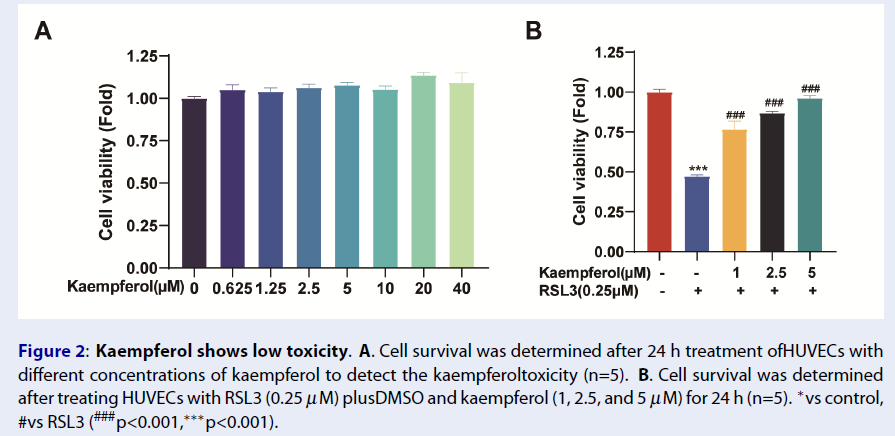Kaempferol Rescues Vascular Endothelial Ferroptosis by Inhibiting Lipid Peroxidation
DOI:
https://doi.org/10.15419/bmrat.v11i4.880Keywords:
kaempferol, lipid oxidation, ferroptosis, SLC7A11, GPX4Abstract
Introduction: The vascular endothelium plays a pivotal role in maintaining vascular function and physiological balance. The degradation and injury of endothelial cells are critical pathological events in the progression of vascular diseases, leading to cell death. One such cell death mechanism, ferroptosis, is an iron-dependent form of necrosis characterized by extensive lipid peroxidation-mediated membrane damage and the toxic effects of iron and lipid peroxidation. Kaempferol, a flavonoid, is celebrated for its antioxidant, anti-inflammatory, and anti-cancer properties. Despite these benefits, the impact of Kaempferol on endothelial cell ferroptosis and its potential therapeutic applications in vascular diseases have yet to be fully elucidated.
Methods: Cell viability was assessed using the Cell Counting Kit-8 (CCK-8) assay. Oxidative stress and lipid peroxidation were measured using Dihydroethidium (DHE) and C11-BODIPY 581/591, respectively. The protein and RNA levels of ferroptosis-associated molecules, including solute carrier family 7 member 11 (SLC7A11) and glutathione peroxidase 4 (GPX4), were determined through Western blotting and real-time fluorescence quantitative polymerase chain reaction (qPCR).
Results: Treatment with a glutathione peroxidase 4 inhibitor (RSL3) led to rapid cytotoxicity in human umbilical vein endothelial cells (HUVECs). Notably, Kaempferol demonstrated a significant protective effect against RSL3-induced ferroptosis in HUVECs. Kaempferol treatment reduced the accumulation of reactive oxygen species (ROS) and exhibited distinctive morphological changes associated with ferroptosis. Moreover, Kaempferol treatment resulted in the upregulation of SLC7A11 and GPX4 expression in HUVECs, highlighting its potent ability to mitigate ferroptosis among tested flavonoids.
Conclusions: Kaempferol effectively inhibited RSL3-induced ferroptosis in HUVECs by modulating the expression of SLC7A11 and GPX4, thereby reducing lipid peroxidation. These findings underscore the therapeutic potential of Kaempferol in the treatment of vascular diseases, paving the way for its application in clinical settings.

Published
Issue
Section
License
Copyright The Author(s) 2017. This article is published with open access by BioMedPress. This article is distributed under the terms of the Creative Commons Attribution License (CC-BY 4.0) which permits any use, distribution, and reproduction in any medium, provided the original author(s) and the source are credited.
